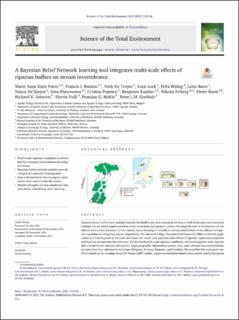| dc.contributor.author | Forio, Marie Anne Eurie | |
| dc.contributor.author | Burdon, Francis J. | |
| dc.contributor.author | De Troyer, Niels | |
| dc.contributor.author | Lock, Koen | |
| dc.contributor.author | Witing, Felix | |
| dc.contributor.author | Baert, Lotte | |
| dc.contributor.author | De Saeyer, Nancy | |
| dc.contributor.author | Rîșnoveanu, Geta | |
| dc.contributor.author | Popescu, Cristina | |
| dc.contributor.author | Kupilas, Benjamin | |
| dc.contributor.author | Friberg, Nikolai | |
| dc.contributor.author | Boets, Pieter | |
| dc.contributor.author | Johnson, Richard K. | |
| dc.contributor.author | Volk, Martin | |
| dc.contributor.author | McKie, Brendan G. | |
| dc.contributor.author | Goethals, Peter L.M. | |
| dc.date.accessioned | 2022-07-12T11:32:47Z | |
| dc.date.available | 2022-07-12T11:32:47Z | |
| dc.date.created | 2022-05-06T15:06:08Z | |
| dc.date.issued | 2022 | |
| dc.identifier.citation | Science of the Total Environment. 2022, 810, 152146. | en_US |
| dc.identifier.issn | 0048-9697 | |
| dc.identifier.uri | https://hdl.handle.net/11250/3004668 | |
| dc.description.abstract | Riparian forest buffers have multiple benefits for biodiversity and ecosystem services in both freshwater and terrestrial habitats but are rarely implemented in water ecosystem management, partly reflecting the lack of information on the effectiveness of this measure. In this context, social learning is valuable to inform stakeholders of the efficacy of riparian vegetation in mitigating stream degradation. We aim to develop a Bayesian belief network (BBN) model for application as a learning tool to simulate and assess the reach- and segment-scale effects of riparian vegetation properties and land use on instream invertebrates. We surveyed reach-scale riparian conditions, extracted segment-scale riparian and subcatchment land use information from geographic information system data, and collected macroinvertebrate samples from four catchments in Europe (Belgium, Norway, Romania, and Sweden). We modelled the ecological condition based on the Average Score Per Taxon (ASPT) index, a macroinvertebrate-based index widely used in European bioassessment, as a function of different riparian variables using the BBN modelling approach. The results of the model simulations provided insights into the usefulness of riparian vegetation attributes in enhancing the ecological condition, with reach-scale riparian vegetation quality associated with the strongest improvements in ecological status. Specifically, reach-scale buffer vegetation of score 3 (i.e. moderate quality) generally results in the highest probability of a good ASPT score (99–100%). In contrast, a site with a narrow width of riparian trees and a small area of trees with reach-scale buffer vegetation of score 1 (i.e. low quality) predicts a high probability of a bad ASPT score (74%). The strengths of the BBN model are the ease of interpretation, fast simulation, ability to explicitly indicate uncertainty in model outcomes, and interactivity. These merits point to the potential use of the BBN model in workshop activities to stimulate key learning processes that help inform the management of riparian zones. | en_US |
| dc.language.iso | eng | en_US |
| dc.publisher | Elsevier | en_US |
| dc.rights | Attribution-NonCommercial-NoDerivatives 4.0 Internasjonal | * |
| dc.rights.uri | http://creativecommons.org/licenses/by-nc-nd/4.0/deed.no | * |
| dc.title | A Bayesian Belief Network learning tool integrates multi-scale effects of riparian buffers on stream invertebrates | en_US |
| dc.type | Peer reviewed | en_US |
| dc.type | Journal article | en_US |
| dc.description.version | publishedVersion | en_US |
| dc.rights.holder | © 2021 The Authors. | en_US |
| dc.source.pagenumber | 11 | en_US |
| dc.source.volume | 810 | en_US |
| dc.source.journal | Science of the Total Environment | en_US |
| dc.identifier.doi | 10.1016/j.scitotenv.2021.152146 | |
| dc.identifier.cristin | 2022218 | |
| dc.relation.project | Norges forskningsråd: 264499 | en_US |
| dc.source.articlenumber | 152146 | en_US |
| cristin.ispublished | true | |
| cristin.fulltext | original | |
| cristin.qualitycode | 2 | |

